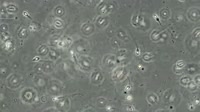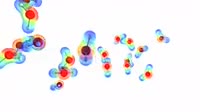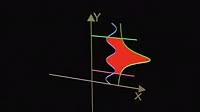Animation of a model of a molecule of carbon dioxide (CO2), showing the distribution of electric charge around it. Here, red areas have a slight negative charge, blue ones a positive charge. This arises as the oxygen atoms are more electronegative than the carbons, and thus attract the bonding electrons towards themselves, leaving the carbon with a slight positive charge. Electronegativity is a measure of an atom's ability to attract electrons, and is related to the number of protons it has in its nucleus, and the number of electron shells around the nucleus. In asymmetric molecules such as water, this separation of charge leads to the formation of two oppositely-charged poles, and the molecule is said to be polar. In carbon dioxide, however, the symmetry of the molecule means that it does not have poles of different charge, and the molecule is non-polar. At a macroscopic level, intermolecular attraction between opposite poles of polar molecules mean that they typically have higher melting and boiling points that non-polar compounds.
Details
WebID:
C01808501
Clip Type:
RM
Super High Res Size:
1920X1080
Duration:
00:00:10.000
Format:
QuickTime
Bit Rate:
24 fps
Available:
download
Comp:
200X112 (0.00 M)
Model Release:
NO
Property Release
No













 Loading
Loading